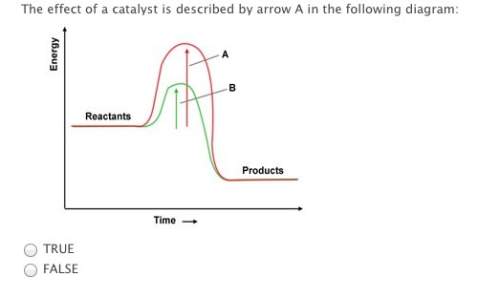
Chemistry, 30.10.2019 21:31 demetriascott20
According to the collision theory of chemical reactions, an increase in the number of effective reactant collisions per unit time will increase the rate of the reaction.
true
false
you can study reaction rates to answer which of the following questions?
will the reaction go to completion?
will the reaction occur?
how can the reaction be slowed down?
how many grams of product will be made?
changing the concentration of one or more of reactants can affect the rate of a reaction.
true
false
if the surface area of reactants decreases:
the reaction rate is generally lower.
the reaction rate is generally higher.
the reaction rate is not affected.
the effect on reaction rate cannot be predicted.
which of the following would increase the rate of a chemical reaction?
reducing the temperature
increasing volume
using reactants in fine, powder form, rather than large, chunky form
decreasing reactant concentration
in an energy diagram for an endothermic reaction, the products are higher in energy than the reactants.
true
false
a catalyst works by increasing the activation energy needed for a reaction.
true
false




Answers: 1
Another question on Chemistry

Chemistry, 22.06.2019 03:40
Astudent is given a sample of a blue copper sulfate hydrate. he weighs the sample in a dry covered porcelain crucible and got a mass of 23.875 g for the crucible, lid, and sample. the mass of the empty crucible and lid was found earlier to be 22.652 g. he then heats the crucible to expel the water of hydration, keeping the crucible at red heat for 10 minutes with the lid slightly ajar. on colling, he finds the mass of crucible, lid, and contents to be 23.403 g. the sample was changed in the process to very light clue anhydrous cuso4. if there are again 100.0 g of hydrate, how many grams of cuso4 are in it? how many moles of cuso4? (hint: molar mass of cuso4 = 159.6 g / mole. what per cent of the hydrate is cuso4? you may convert the mass of cuso4 to moles.)
Answers: 3

Chemistry, 22.06.2019 04:40
Silver tarnishes as silver metal reacts with hydrogen sulfide, h2s, in the air. in this reaction, dark silver sulfide, au2s, covers the surface of silver. when silver is polished, this coating of silver sulfide can be removed from the surface. this makes the silver shiny again. enter the coefficients that balance the tarnishing reaction equation. (type 1 for no coefficient.)
Answers: 2

Chemistry, 22.06.2019 09:30
Which ocean zone has the most abundant primary producer and why a) the abyssopelagic zone ,du to the absence of light and cold water temperatureb) the bathypelagic zone, due to the absence of light and cold water temperaturec) the mesopelagic zone ,due to uts high light availability and warm water temperature d) the epipelagic zone,due to its high light availability and warm water temperature
Answers: 3

Chemistry, 22.06.2019 13:30
Astudent is trying to create a table that compares hypotheses, theories, and laws. hypothesis theory law do scientific researchers formulate it? yes yes yes does it explain why things happen? yes yes no yes yes yes is it used to make predictions? no yes yes which of the following questions would most likely fill the blank in the table? is it an intelligent guess? is it newly formulated? is it based on observations? has it been proved?
Answers: 1
You know the right answer?
According to the collision theory of chemical reactions, an increase in the number of effective reac...
Questions

Mathematics, 30.06.2019 04:00

Mathematics, 30.06.2019 04:00


Biology, 30.06.2019 04:00

English, 30.06.2019 04:00


Mathematics, 30.06.2019 04:00

Spanish, 30.06.2019 04:00


Mathematics, 30.06.2019 04:00







French, 30.06.2019 04:00



Mathematics, 30.06.2019 04:00



